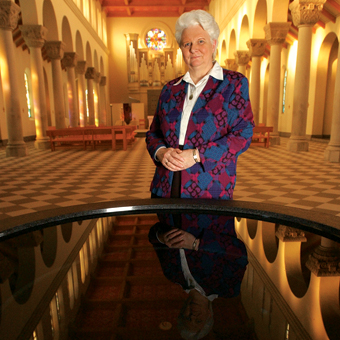Having taught in and studied seminaries for 20 years, Katarina Schuth sizes up the changes in today's seminaries and the men they are forming for the priesthood.
Karatina Schuth didn't set out to study seminaries. With a doctoral degree in cultural geography, she had researched literacy in rural India, taught at a Minnesota college, and studied moral theology. Her work on seminaries initially just fell into her lap, she says.
But ever since her first book on seminaries appeared in 1989, Schuth has more than earned her status as a national expert on theological education with her continuing studies of the subject and, more recently, her work on priests ministering in multiple parishes.
For 15 years she was a formation adviser at St. Paul Seminary School of Divinity, of the University of St. Thomas in St. Paul, Minnesota, where she also teaches. Schuth praises the seminary's teaching parish program, which gives seminarians a taste of life in the trenches. In their first year, each seminarian is placed in a parish where the pastor and staff, together with 12 laypeople, form a team that works with the seminarian for four years.
"The advantage," says Schuth, "is that it's not ‘Here comes the wonderful seminarian,' who then leaves after two or three months, but rather the seminarian is there for the long haul, someone the parish is helping to form to become a good pastoral minister. I would say it's been quite successful."
Compared with entering the seminary 50 years ago, how would the seminary experience be different today?
Like night and day. For one thing, young men usually presented themselves for priesthood starting in high school. Fifty years ago there were high school seminaries all over the country with thousands of boys attending. Even as late as 1967 there were almost 16,000 students in high school seminaries and 13,000 in colleges, in contrast to today with 729 in high schools and 1,300 in college seminaries. The only pathway into major seminary in the past was through a college program. In fact, men couldn't even enter the seminary if they were over 30 or 35 years of age.
After their time in high school and college seminaries, candidates went to a major seminary to study theology, which in those days usually was located in a somewhat isolated environment. Seminarians rarely left the seminary grounds, and, of course, they had to take their theology courses in Latin. Many of them had trouble with language study. I know older priests who said they never understood much of it and just got the notes from their classmates who did get it. The life was extremely regimented, and they could be dismissed for the least infraction. Personal spiritual direction was uncommon; most activities were in large groups and one-on-one spiritual formation was usually limited to Confession.
When priests were ordained, most often around age 25 or 26, they were sent to a parish under the mentorship of a pastor. They had limited duties, and they often didn't become pastor of a parish for anywhere from 10 to 25 years.
How does that contrast with today?
The average age of those ordained in the last five years or so is 36. One of the effects of that fact is a 10-year difference in the average length of service a priest will normally give, although now they're expected to work later in life, with retirement often at 70 or older.
Only 37 percent who enter a major seminary come from college seminaries, and most of the others go through an official two-year pre-theology program (after college but before major seminary). Those programs were established in the late 1970s and early 1980s because older candidates needed a path other than entering the college seminary with a lot of 18-year-olds. Typically pre-theology students are older and have worked for a while.
How does the new system compare with the old?
Each system was designed for the times. The seminary programs since the 1970s provide considerably more individualized formation and more contact with parishes and other church institutions. Faculty include not only priests but also some women and lay men.
Many priests who went through the older system say there were some problems with it. I don't like to be too critical of the past, because leaders did the best they knew how and were following a system that had existed for a long time. It only started to change in the late 1960s, really. Seminaries did a remarkable job of making a relatively quick transition into a very different kind of system. By the end of the 1980s they had solid programs in place in three of the four main areas of seminary formation. As we know now, most of the sexual abuse problems came out of the old system. We don't know for sure whether the lack of contact with people and the lack of education around human issues and relationships were the causes of all that. Certainly some priests who were educated later with this background also abused minors.
What are those areas of formation?
The two on the more intellectual side are academic and pastoral formation, and the personal side would include spiritual and human formation. The first three of these have traditionally always been covered in seminary programs.
In 1992 Pope John Paul II released an influential document, Shepherds After My Own Heart, which was widely embraced by seminaries, both diocesan and religious. It's seen as a balanced and helpful document, and in it the pope talked about the importance of human formation, saying that those studying for the priesthood have to become persons who can be a bridge to people and not be the cause of people separating from the church. As a result, human formation became a fourth area for seminaries to address.
How does a seminary help to form a man for priesthood?
All four areas of formation are important in the process. Most development has occurred recently with human formation, which is done less formally. On the celibacy issue, for example, seminary personnel discuss sexuality, family life, marriage, and all the things one needs to understand as a sexual person, as a person who will be providing ministry that focuses on relationships with others and requires appropriate boundaries.
Those involved in human formation also strive to see what kind of person the candidate is and whether he is developing his spiritual side. The formation adviser meets with him once a month at least, and there are retreats and workshops with speakers on topics from liturgical prayer and importance of a devotional life to alcoholism and domestic violence, among others.
Since the 1980s the requirement has been for a seminarian's spiritual director to be a priest, and now the formation adviser also must be a priest. I was a formation adviser for 15 years at our seminary, but as of last year I can no longer work in that role.
Do you think we are starting to backtrack toward something resembling the old seminary system?
It's too early to say. Right now there's an effort to adjust to a new situation, and I'm not sure just what the correct reading of this situation might be, but unfortunately we won't know that for a long time. I think priests coming out of the seminary between, say, 1975 and 2000 were basically quite well prepared and changes to the program should be made with care.
I'm a little concerned that some of the newer priests are not educated enough about working with laypeople and don't want to give authority to laypeople as readily as the priests before them. Signs of problems are present, but what the extent of that will be as these men mature, we don't know.
Would this come from their experience in the seminary or from who they were before they even entered?
It's both, I think. I've worked extensively with experienced vocation directors, and what I've heard recently is that new seminarians tend not to reflect the whole spectrum of their peer group-they tend to come mainly with a far more traditional viewpoint. Their peers-for example, most undergraduates I teach at the University of St. Thomas-tend not to be as highly committed to the church as seminarians are, and so they find it difficult to identify with some of the more traditional approaches.
What about the international students?
About 33 percent of college seminarians and pre-theology students are born outside the United States. People from other cultures don't have the same tendencies toward one ideology or another that men from the United States seem to have. They're not as wed to some of the traditional attitudes.
While they may have traditional piety as part of their ethnic backgrounds, they typically are not as focused on ideological positions.
When you talk about traditional modes of priesthood, what do you mean? How do priests coming out of seminaries see themselves?
The lingo that's often used contrasts what are called the "cultic model" and the "servant-leader model."
A cultic priest would see his role as primarily centering around being the eucharistic leader, with worship and the sacraments as central, as one set apart, with a view that he is in charge, the ultimate authority. (Of course, in the actual parish structure, that's true.) But such priests would see parish staff as working for them rather than as part of a team. Their piety would be more traditional. Many of these men couldn't wait for the Latin Mass to become an option. Clerical dress means a lot, and more and more the cassock is coming back with this population. I'm describing a little more of the extreme of this model, but it serves to make the distinction.
The servant-leader model would be a priest who is the leader of the community, but one among the people to serve them, emphasizing collaboration rather than domination. They would really count on the expertise of their professional staffs and use it well. With this model some felt the lines between priests and laity were too blurred.
What kind of priest do you think the broad middle of Catholic America wants?
The broad middle wants a priest who is an inclusive servant leader, to be part of the people, be one with them, not to be above and apart from them. At the same time they expect the priest to have some characteristics of the cultic model-to be deeply spiritual, a good homilist and leader of worship, and one who can engage the Christian community.
I've heard priests from the younger generation say, "No, no, we're not only cultic, we're the servant model, too." They have an idea of the value of both, of course, but the real question is whether they have the willingness to be both. Some of the younger men being ordained today are absolutely more oriented toward the servant model, but the majority would not move in that direction. The opposite might be said of some servant leaders.
How has the abuse crisis affected seminaries?
I tend to agree with Scott Appleby of Notre Dame that it's the greatest blow the Catholic Church in the United States has ever experienced. The repercussions of it are so widespread and not yet entirely identified, but the effects keep appearing in areas such as finances, lack of vocations, attitudes toward priests. All of that has deeply permeated and damaged the church.
The resulting attitude of many seminarians is, "We're not going to be like that. Those people destroyed the church." Some tend to group anyone older into that category, deepening the divide. We won't know for some time if they will have their own offenders, but there is a great determination among them to avoid any scandal. The abuse crisis did not deter them from entering the seminary, but we don't know if some did not enter who might have had the abuse not occurred.
I've noticed that there's a real tightening up of what is taught and how it's taught and who is teaching. It comes out of fear, in some cases, and aims to make sure that seminarians are clearly getting the idea of what is right and what is wrong. Church teachings do have to be extremely clear, of course, but the changes also can be accompanied by less engagement with the community, more holy hours, and a return to more traditional piety that may or may not fit with parish life today.
Can the seminary teach a man to be pastoral when he goes out in a parish?
If a seminarian comes in with a sense of relating to and caring about people, you can tell that right away. I teach first-year seminarians, and within two or three months it is quite clear who will be good with the pastoral side of ministry. Some have it naturally, others have to learn.
The pastoral settings where they spend ministry time are very important to their understanding of themselves. When they first go out into parishes, faculty assure them, "You don't have all the answers, and don't think that you have to have them."
Are they expected to collaborate with laypeople?
Certainly they are, but again it can depend on what they are taught in the seminary. In my pastoral ministry course, for example, we discuss what collaboration means. Put simply, does it mean, "I'm in charge, and you do what I say, but we'll talk about it," or does it mean, "Let's talk over what we're going to do"? It takes time to learn the skills needed to lead in a collaborative way.
You've said that recruiting people to become priests is not just the job of the seminary system but of everyone. What do you mean?
As the number of priests diminishes, the average Catholic is beginning to see this loss as more of a concern than in the past. Currently a great effort is made on the parish level to pray for vocations and even to ask a likely candidate, "Have you ever thought of priesthood? I think you have many of the right gifts to be one."
We're starting to understand the priest shortage, but we need to have greater awareness, because we're coming to a crisis. By 2010-that's in just three years-we will see a decline of 12 percent in the number of priests, according to some estimates.
I will say, however, that parents wanting their own child to become a priest is another matter entirely.
Why?
The small number of children in families is a huge deterrent, I think. For one thing, parents want grandchildren. In the past, when Catholic families had, say, five children, it was a real honor to have a son or daughter enter religious life or the priesthood. Now, with only one or two children, it isn't seen that way. Again this is, in part, one of the aftereffects of the abuse scandal: Not only have we lost the encouragement of families-particularly of mothers-but they are sometimes outright discouraging their sons from considering priesthood.
Also the economic status of Catholics in general has risen; people tend to aim for professions where they can earn a lot of money.
The situation can sound bleak at times. Do you have hope for what's facing seminaries and the church?
Yes, I'm a person of hope. There's something about the Catholic faith that is utterly resilient. I do believe in the Spirit. The older I get the less I think I'm going to live to experience the fullness of the resilience that I know will come. The church has had its ups and downs, and right now we are in a time when many good people who have been part of the church are not feeling satisfied, and this happens for many reasons. Some feel they lost their homestead in a sense. Many people are striving to find it, but some people have given up.
I haven't given up. I believe deeply in the Eucharist, and that would keep me in the church no matter what happened, that and the social teachings of the church as proclaimed in the gospel. That's enough for me, but it's not enough for some people. I grew up in the 1950s, and there's a depth to one's faith that comes from growing up in an all-embracing Catholic culture-it's just an unshakable part of my life.
This article appeared in the November 2007 issue of U.S. Catholic (Vol. 72, No. 11, pages 24-29).














Add comment